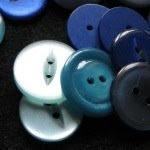Anyway, deep in amongst these buttons were some Civil Defence ones, some British Red Cross ones and a few others that dated the collection to somewhere around the 1940s - 1950's. And there was this one:

The back is Bakelite or some other form of early plastic, as is the symbol on the front. What with the Mr and his business I'm getting moderately familiar with oriental bits and pieces and my hunch said 'Japanese' as opposed to Chinese or Korean.
But that was as far as I got. Trying to play snap on Google with kanji is no my idea of fun and a bit of a waste of time. Last night, though, I got chatting with Cindy and she cast a bit more light on things.
Now, traditional Japanese clothing doesn't have buttons. Things are folded and tied, elaborately, and apart from clips and bone fastenings on some armour pieces, buttons aren't really a feature.
But it seems the kanji (Cindy agrees most likely Japanese) is kotobuki, derived from the characters for 'long life' and 'celebration' and as such may well have been part of some sort of gift. A pouch perhaps, containing something for a special birthday? Maybe it marked a coming-of-age date? Perhaps even good wishes at a birth?
I had planned to sell this on, but I have to say I'm getting intrigued by it now. What is it? Where did it come from and how on earth did it end up in England?
I'm also wondering what to do with it. The silk bags over at Etsy were, originally, inspired by some Japanese folded patchwork. There isn't any obvious link there (except in my own mind) and I've recently been using Japanese dyeing techniques to colour-match thread for an antiques restorer.
I'm sitting writing this in a room filled with obi, sageo, a yari, katana and tanto and every sort of sword fitting you could imagine (and some you possibly can't). And a statue of Fudo-myoo standing in the corner.
Thinking about it, maybe this one isn't for sale after all!
